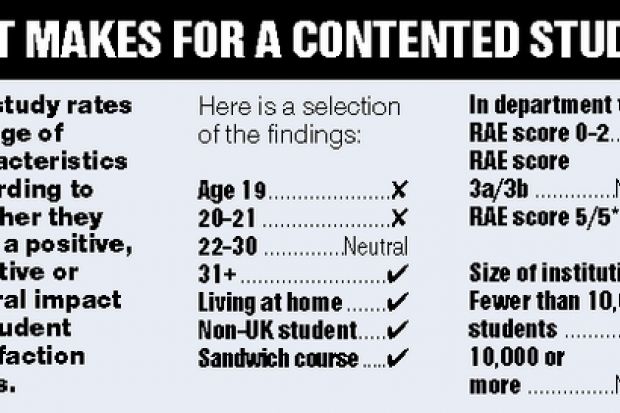Academics with a gift for teaching are more likely than any other aspect of campus provision to leave students satisfied with their university overall, according to a study published this week.
Out of six categories, teaching and learning had the strongest effect "by far" on students' levels of satisfaction with their university, according to an analysis of data from the National Student Survey.
The study, compiled for the Higher Education Funding Council for England by Paula Surridge of Bristol University, found that the most satisfied students in Britain were white, female, aged over 30, living at home and studying on a sandwich course in the physical sciences, languages or philosophy.
Respondents in institutions with fewer than 10,000 students and in departments with top research assessment exercise scores also tended to be the happiest.
The analysis suggests that any institution that manages to recruit enough students that fit the profile that emerged in the survey - and provide them with the "ideal" study conditions - will be likely rise to the top of student satisfaction charts in the next survey.
The least satisfied in the country were young Asian male students on agriculture, computer science, engineering, social studies, business, communication studies, design or education courses attending a big institution in a department with a low RAE score.
The student survey, which is in its second year, rates universities by the level of satisfaction expressed by students across six categories. These include teaching and learning, assessment and feedback, academic support and organisation and management.
Ms Surridge, a sociology lecturer, analysed the 2005 survey results - applying filters such as age, gender and subject choice - to learn how such factors affected students' verdicts and so overall satisfaction levels.
She discovered "important differences" between student groups and course types and found that these could have a strong influence on the outcome of the survey.
Failing to take these factors into account can result in a misleading interpretation of the results, an accompanying report by Hefce says.
The Hefce report says that institutions with a high proportion of the "wrong" kind of students can therefore be disadvantaged.
It says that student profiles must be taken into account when making any comparisons using the results of the student survey.
"Raw" figures that do not take account of the characteristics of students, courses and institutions may produce, at best, misleading and, at worst, invalid measures of teaching quality, Hefce says.
Ms Surridge said that although the student profile was similar in many institutions, it could be misleading to compare the survey results of universities with very different profiles.
The same problem could arise if institutions used the results to compare departments internally.
Hefce adds: "The research by Paula Surridge is a major step forward in understanding the outcomes of the survey.
"The findings will enable universities and colleges to reflect further on their learning and teaching provision and address areas that need attention."
Liz Beaty, Hefce's director of learning and teaching, said that Hefce would be working with the Higher Education Academy and others to improve teaching provision and that the Bristol research would help inform future policy development.
Register to continue
Why register?
- Registration is free and only takes a moment
- Once registered, you can read 3 articles a month
- Sign up for our newsletter
Subscribe
Or subscribe for unlimited access to:
- Unlimited access to news, views, insights & reviews
- Digital editions
- Digital access to THE’s university and college rankings analysis
Already registered or a current subscriber? Login
